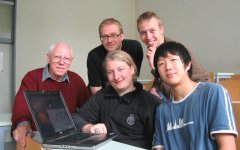News archive
2005 Impact Factor: 4.223 (June 2006)
It is with a great pleasure that we communicate to you the new impact factor of ISI.
Astronomy & Astrophysics (0004-6361) benefits from an impact factor of 4.223 with 68577 quotations.
2007 Impact factor rises (June 2008)
We are very pleased to inform you of the 2007 A&A impact factor: 4.259 which was released on 18 June 2008 by the Journal Citation Reports, ISI Web of Knowledge.
Astronomy & Astrophysics articles were the second most cited with 76,647 citations in 2007.

2008 Impact factor (July 2009)
The Astronomy & Astrophysics ISI impact factor for 2008 is 4.153.
Astronomy & Astrophysics articles were cited 79,218 times in 2008.
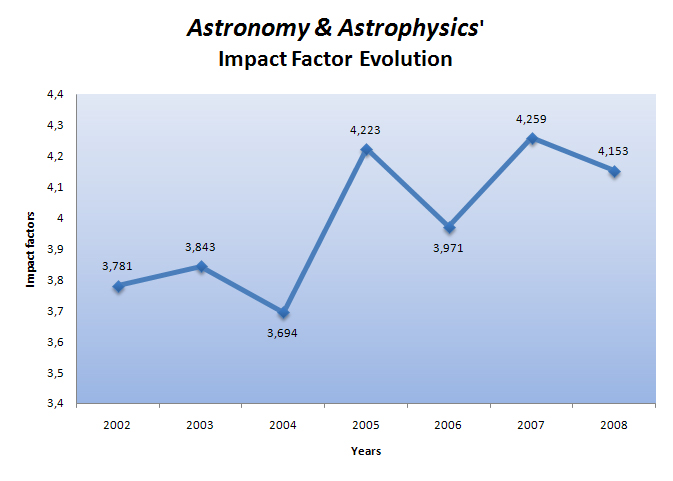
2009 Impact Factor (June 2010)
The Astronomy & Astrophysics ISI impact factor for 2009 is 4.179.
Astronomy & Astrophysics articles were cited 88,679 times in 2009.
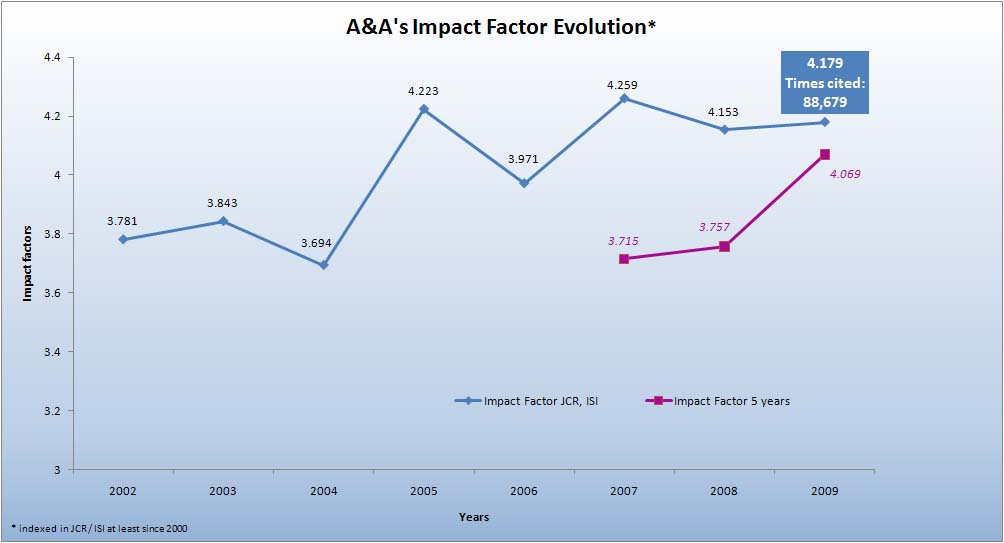
2010 "School meets Science" prize for Beuermann et al. (2009) (September 2010)
Astronomy & Astrophysics is proud to report that the German high-school program that led to a Research Note (Beuermann et al. 2009, A&A, 507, 385), and highlighted in an A&A press release has won the Bosch Foundation "School meets Science" prize for 2010.
2010 Impact Factor (July 2011)
The Astronomy & Astrophysics ISI impact factor for 2010 is 4.410.
Astronomy & Astrophysics articles were cited 89,585 times in 2010.
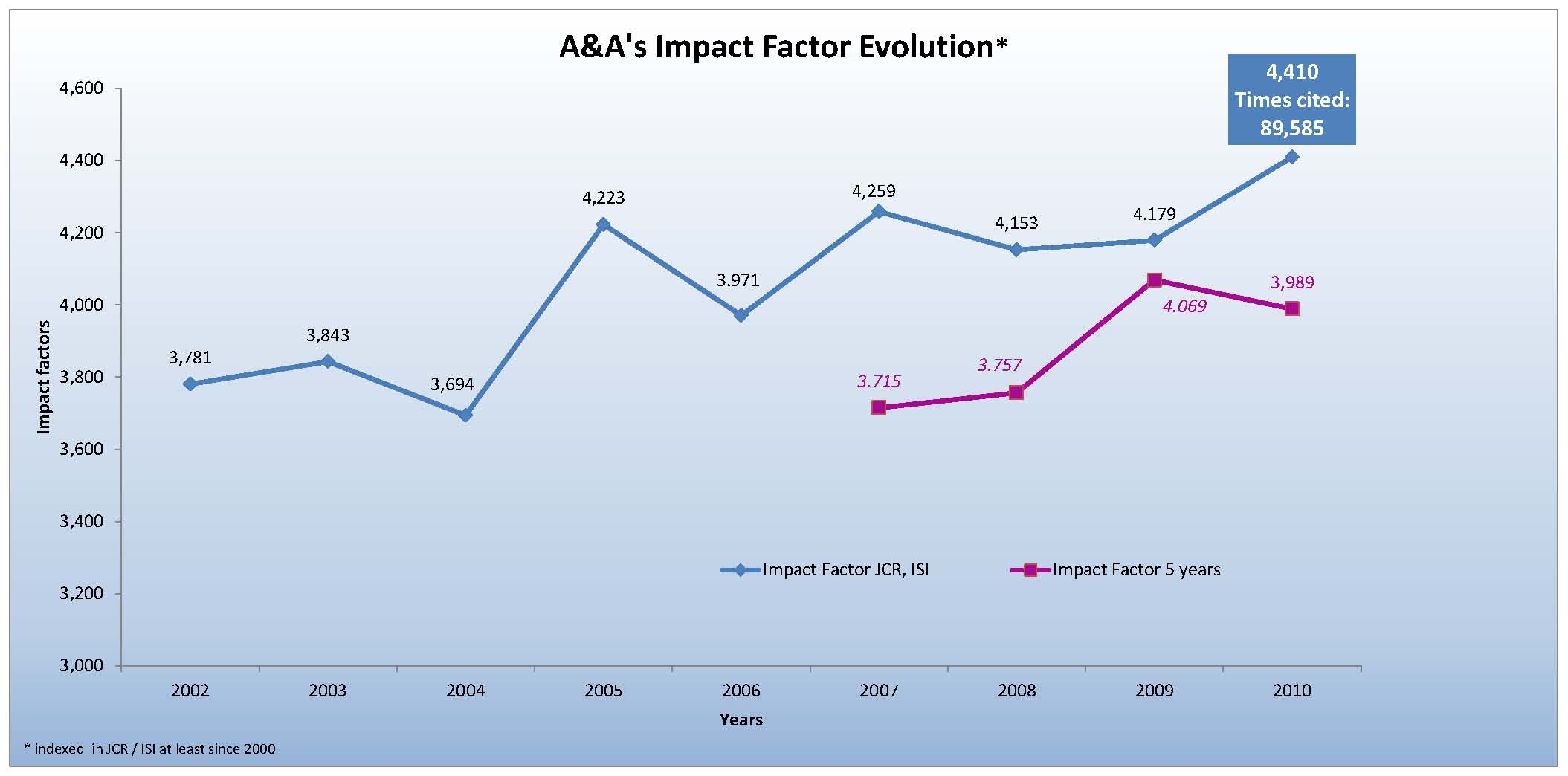
2011 Impact Factor (July 2012)
The Astronomy & Astrophysics ISI impact factor for 2011 is 4.587.
Astronomy & Astrophysics articles were cited 90,096 times in 2011.
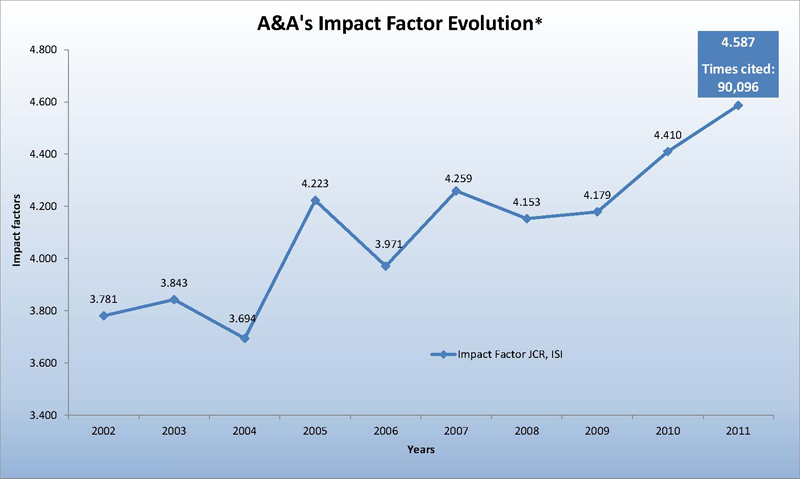
* Indexed in JCR / ISI at least since 2000.
2012 Impact Factor (July 2013)
The Astronomy & Astrophysics ISI impact factor for 2012 is 5.084
Astronomy & Astrophysics articles were cited 101,305 times in 2012.
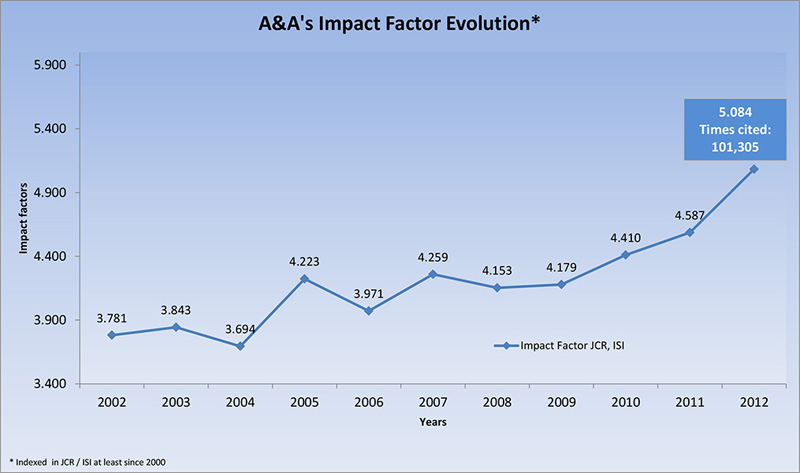
2nd Astronomy and Astrophysics School: Scientific Writing for Young Astronomers (Jan. 2009)
EDP Sciences and A&A are glad to announce the “Second Astronomy and Astrophysics School: Scientific Writing for Young Astronomers” which will be held in Blankenberge, Belgium, from 18 to 20 May 2009.
The direct purpose of organising an “A&A School” is to teach young authors how to express their scientific results through adequate and efficient science writing. In other words: how to write scientific papers for different forums (journals, proceedings, thesis manuscripts, etc.).
Visit the website at www.swya.org
You can download the announcement.
3rd Scientific Writing for Young Astronomers (February 2014)
EDP Sciences and Astronomy & Astrophysics are glad to announce the “3rd Scientific Writing for Young Astronomers”, which will be held in Tihany, Hungary, from 24th to 28th August, 2014.
The direct purpose of organizing an “Astronomy and Astrophysics School” is to teach beginning PhD Students how to express their scientific results through correct and efficient science writing. In other words, how to write scientific papers for different forums (journals, proceedings, thesis manuscripts, etc.)
For further information, we invite you to visit our website and to like our Facebook page “3rd Scientific Writing for Young Astronomers”.
László L. Kiss
Director of the school
3rd Scientific Writing for Young Astronomers 2014 (September 2014)
A&A organized the 3rd Scientific Writing for Young Astronomers from 24th to 28th August 2014, in Tihany (Hungary). 49 students and 12 lecturers participated in this 3rd school. The direct purpose was to teach new PhD Students how to express their scientific results through correct and efficient science writing and how to write scientific papers for different forums (journals, proceedings, thesis manuscripts, etc.).
Overall, both students and lecturers appreciated the 3rd SWYA. They obtained useful information and liked the friendly and professional approach.
We invite you to visit the SWYA website and see the different comments and pictures of SWYA 2014: http://www.swya.org/.
4th Scientific Writing for Young Astronomers 2016 (December 2015)
EDP Sciences and Astronomy & Astrophysics are glad to announce the "4th Scientific Writing for Young Astronomers", which will be held in Puerto Varas, Chile, from 19th to 22th April, 2016.
The direct purpose of organizing an “Astronomy and Astrophysics School” is to teach beginning PhD Students how to express their scientific results through correct and efficient science writing. In other words, how to write scientific papers for different forums (journals, proceedings, thesis manuscripts, etc.)
For further information, we invite you to visit our website and to like our Facebook page "Scientific Writing for Young Astronomers".
Patricio Rojo
Director of the school
A reduced Open-Access embargo period for A&A (June 2012)
All Astronomy & Astrophysics articles are now in open access two years after their publication date, rather than two years after the end of the calendar year of their publication. This reduces the open-access embargo period for the journal by an average of six months.
A&A announces its new Impact Factor is 5.185 (June 2016)

The latest Journal Citation Reports® recently announced by Thomson Reuters have revealed that Astronomy & Astrophysics’ Impact Factor has risen to 5.185*.
This confirms A&A’s position as one of the leading journals in the field, publishing the very best papers on all aspects of astronomy and astrophysics.
Click here to read the journal or to submit a paper.
*2016 Release of Journal Citation Reports. Source: 2015 Web of Science Data"
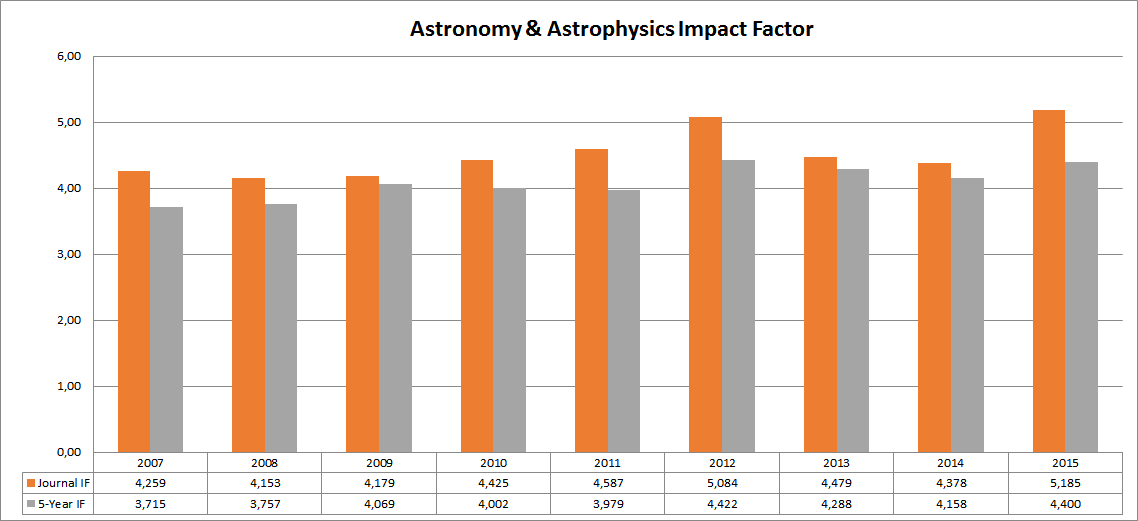
A&A at the XXVIII General Assembly of the IAU (August 2012)
A&A has a booth on the XXVIII General Assembly of the IAU held in Beijing from 20 to 31 August and is the sponsor of the poster session.
A&A is also part of the “Workshop for Journal Authors and Referees” at the XXVIII General Assembly of the IAU.
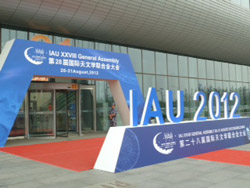
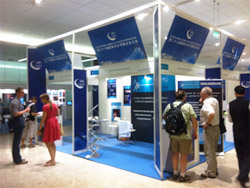
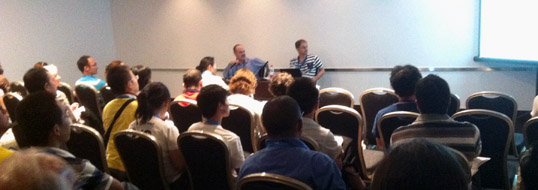
A&A is now available in a mobile-optimized format (March 2012)
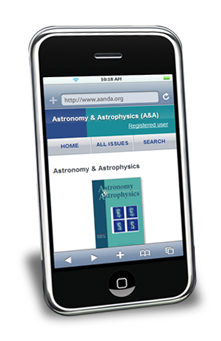
All visitors using either their smartphone or their tablet device will be automatically redirected to the mobile version of the Astronomy & Astrophysics website.
The mobile A&A site offers an easy access to current and archive content, and a quick search function.
Subscribers can now view content in a format designed specifically for their mobile device.
A&A Journal and EDP Sciences launch Writing Studio to support their authors (March 2016)

Astronomy and Astrophysics (A&A) Journal and EDP Sciences are pleased to announce the launch of Writing Studio, a unique collaborative writing LaTex solution designed to simplify the process of writing an article collaboratively on a single version of a paper. Reinforcing an open-source strategy, EDP Sciences has chosen the Open Source ShareLateX to develop this new service.
Writing Studio provides:
- A collaborative LaTeX solution: Multiple co-authors can jointly work on a single version of the paper with up-to-date A&A macros already included.
- Direct communication between co-authors: Co-authors can ask each other questions and can chat for real-time interactions.
- Dropbox integration: Articles can be edited offline and automatically synchronized with the Dropbox online copy.
- Ease of submission (coming soon): Article will be uploaded to the A&A submission system with a single click, with key fields pre-filled ready for checking.
- Easier links to astronomical objects: Authors get auto-completion for stellar objects and additional information using tools developed with the CDS.
- ORCID integration: Authors login to Writing Studio and are recognized by their ORCID iD.
The next step is to link Writing Studio with all the EDP Sciences journals and their submission systems and integrate this tool in a comprehensive LaTeX dedicated workflow, from the writing of an article through to its online publication.
Login to the Writing Studio using your ORCID iD.
Read Press Release for more information
A&A makes the transition to article-numbering (January 2010)
The Editorial on the transition to article numbering can be consulted in A&A, vol. 509, E1, 2010.
Quick dissemination of validated science results is an important aspect of academic publishing. Over the years, the electronic
editions of journals have become the primary vehicle for achieving that objective. With the new contract period for publishing
A&A, the preparation of the electronic edition is being optimized for speed of publication.
To streamline the production of the Journal, it has appeared useful to change from the classical "page-numbering system" to a
more flexible "article-numbering system". This means that, as of January 2010, articles will be marked according to their class of
publication using a roman letter: L for Letter, A for Article, E for Editorial, C for Corrigendum, etc. Furthermore, the articles of
each class of publication will be given a number in the volume based on the sequence in which they are ready for publication in that
volume of A&A.
Published manuscripts will thus be numbered in A&A with a number preceeded by a roman letter signifying the publication
class. The result is that they will appear in A&A as, e.g.,
A&A 512, L1 for the Letter that is published first in Volume 512
A&A 512, A12 for the twelfth published article in the same volume
A&A 512, A13 for the thirteenth published article, and so on.
A&A 512, L1 (2010) and A&A 512, A12 (2010).
The page numbering will be internal to each manuscript, i.e., the first page of each paper will always be numbered as 1. The page number will be located at the bottom of each page and will take the form "Page n out of N" where N is the total page number of the manuscript and 1 ≤ n ≤ N.Finally, the paper’s reference will be repeated as the running title of even-numbered pages while the running title of oddnumbered pages will be left unchanged.
The manuscripts accepted for publication will appear in the currently opened A&A volume as soon as they are ready to become public. A&A users will also be able to see on the Journal website how the open volume is being filled up every day with newly published manuscripts. At the closure date of the volume, its contents will be sent to the printer. The printed volumes of A&A will contain the publications in the sequence E1, E2, etc., L1, L2, L3, etc., A1, A2, A3, etc. However, the A&A website and the table of contents of each volume will display the published papers in the usual manner, with a table of contents sorted by sections.
Authors do not need to worry about the changes, since everything will be taken care of in the editorial and production process.
Citing an article will be in a format only slightly different from earlier since there will always be a capital letter in front of the last number. For Letter number 4 and article number 12 in Volume 552, the references will be as follows.
Writer, U.V., & Author, B. C. 2010, A&A, 552, L4
Author, B. C. 2010, A&A, 552, A12
A&A Now available on ePUB format! (April 2014)
EDP Sciences is pleased to announce the introduction of the ePUB digital format for all A&A articles.
We have extended our existing suite of publication formats (PDF, HTML) to include ePUB, offering a range of formats to suit our readers varying needs.
ePUB is a format used for digital documents, it will allow scientific articles to be read on most of specialized eReaders and tablets.
The ePUB version will allow to download scientific texts and to read them very easily in an offline environment. ePUB adapts to suit different screen sizes, making for optimum text display and greater reading comfort.
We also plan to add, in following weeks, a button “Send to my Kindle” in addition of the different electronic formats.
For a free trial or additional information: This email address is being protected from spambots. You need JavaScript enabled to view it.
A&A publishes Gaia Special Issue (November 2016)

Astronomy & Astrophysics, published by EDP Sciences, has published a special issue gathering papers describing the GAIA data release and their validation.
Gaia is an ESA mission to survey one billion stars in our Galaxy and local galactic neighbourhood in order to build the most precise 3D map of the Milky Way and answer questions about its structure, origin and evolution.
To read the special issue, please click here.



